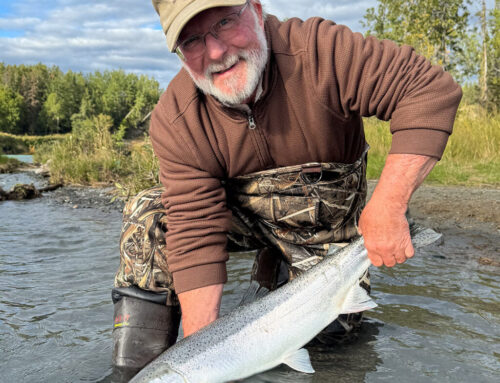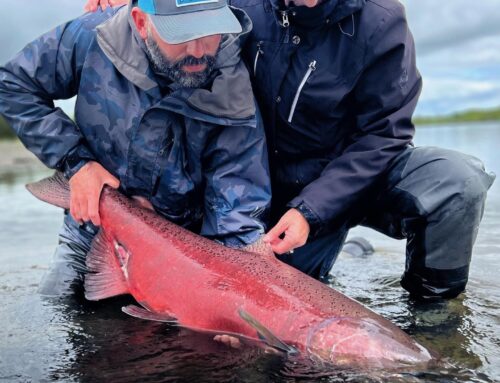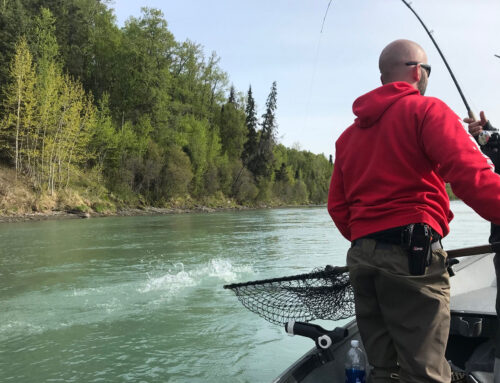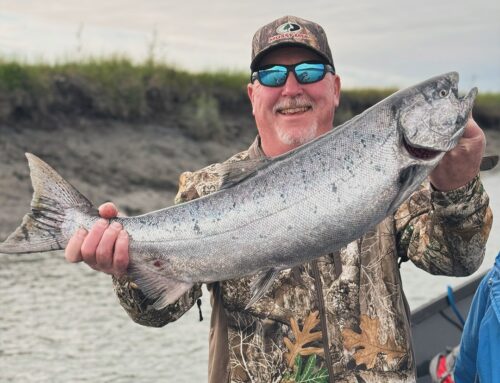The Kenai River in Alaska is a spectacle of nature’s grandeur. It’s a place where the wild meets the adventurous, especially during the sockeye salmon run.
The Kenai River sockeye run is a phenomenon that attracts thousands of spectators and anglers each year. The river’s icy waters teem with vibrant red salmon, making it a sight to behold and a hotspot for fishing enthusiasts.
But it’s not just about the thrill of the catch. The Kenai River sockeye run is a testament to the resilience of nature and the importance of conservation.
This guide aims to take you on a journey through this remarkable event. We’ll delve into the best times to visit, the techniques for fishing, and the significance of this run for the local ecosystem and communities.
Whether you’re an adventure tourism operator, an outdoor activity trainer, or simply a lover of nature, this guide will help you navigate the wonders of the Kenai River sockeye salmon run.
The Kenai River Sockeye Phenomenon
The Kenai River is a world-renowned destination for sockeye salmon, also known as red salmon. This stunning natural event, characterized by the salmon’s vibrant hue as they journey upstream, is a captivating spectacle. The sheer number of fish is a testament to the health of this vital waterway.
At the heart of the Kenai’s allure is its strategic role in the salmon’s life cycle. The river’s cold, clear waters provide an ideal environment for spawning, offering a glimpse into the life of these resilient fish. Visitors and anglers can witness firsthand the determination of sockeye salmon as they overcome obstacles, showcasing the marvels of the natural world.
Understanding the Kenai River Sockeye Run
The Kenai River sockeye run is a fascinating natural cycle. Each year, the river welcomes thousands of sockeye, marking a vital phase in their life journey. This phenomenon brings together both seasoned anglers and new visitors.
The sockeye run is not just about numbers; it’s about timing and rhythms. As the water warms, signals trigger the run, inviting the salmon to return home. For spectators and fishers alike, understanding these cues adds a layer of anticipation and excitement.
Fishing during the sockeye run requires patience and skill. But it also offers an unrivaled connection to nature. Observing these vibrant fish dart against the river’s flow is a humbling experience, reminding us of the intricate balance within ecosystems.
Peak Seasons and Fish Counts
Timing is key for experiencing the sockeye run at its peak. This event usually hits its stride from late July to early August. During this period, the salmon surge upstream in staggering numbers.
Kenai River fish counts, diligently monitored, help track these impressive migrations. The data is crucial for managing fishery stocks and ensuring sustainable practices.
- Late July to early August: Peak run period.
- Daily fish counts: Monitored via sonar.
- Conservation-focused management.
The Role of the Alaska Department of Fish and Game
The Alaska Department of Fish and Game plays a crucial role. They are responsible for the Kenai River salmon count and conservation efforts. Their work ensures the sustainability of this vital run.
By monitoring sonar counts and escapement goals, they protect the future of the sockeye population. This management allows both locals and visitors to continue enjoying this extraordinary natural resource for years to come.
Fishing the Kenai: Techniques and Regulations
Fishing on the Kenai River offers a unique challenge and thrill. Here, anglers employ various techniques to catch the prized sockeye. Popular methods include fly fishing, drift fishing, and bank casting.
Each technique requires specific skills and strategies. Fly fishing demands finesse, drift fishing involves patience, and bank casting often calls for precise timing. Knowing when and how to switch tactics can greatly enhance your success.
Regulations are essential for maintaining the health of the fishery. Anglers must follow strict guidelines set by local authorities to ensure the conservation of sockeye populations. Respecting these rules is key to sustainable fishing and ecological balance
Essential Gear for Sockeye Fishing
When fishing for sockeye, having the right gear is crucial. A sturdy rod and reel, designed for the strength of these fish, is essential. Choosing the appropriate line and lures can also make all the difference.
Anglers should also prepare for variable weather conditions. Layered clothing and waterproof gear ensure a comfortable and enjoyable experience, regardless of the elements. Packing essentials correctly enhances the fishing adventure.
Licenses, Limits, and Legalities
Fishing on the Kenai requires a valid license, which is non-negotiable. Local authorities enforce catch limits to protect the salmon population. Anglers must stay informed about these limits, as they can vary annually.
By adhering to legal regulations, anglers contribute to conservation. This diligence ensures that future generations can experience the joy of sockeye fishing on the Kenai River. Responsible fishing sustains the health of the river for all.
Conservation and Sustainability
Conservation is crucial for the Kenai River’s vibrant ecosystem. The sockeye salmon run, a natural spectacle, relies on balanced environmental practices. Careful management ensures these fish return year after year.
Sustainability efforts focus on maintaining healthy fish populations and habitats. Organizations, alongside community initiatives, work to protect the Kenai’s natural resources. These efforts benefit both the river’s ecology and the local economy.
The Importance of Escapement Goals
Escapement goals are vital for salmon conservation. They ensure enough fish survive to spawn, maintaining future runs. Monitoring these numbers helps set effective fishing regulations.
Without these goals, the salmon population could decline, impacting ecosystems and economies. By prioritizing escapement, we ensure the river thrives for generations to come. Sustainable practices preserve the river’s balance and productivity.
The Economic and Cultural Impact of the Sockeye Run
The Kenai River sockeye run plays a pivotal role in the local economy. It attracts thousands of visitors annually. These visitors contribute significantly to tourism revenues, benefiting various businesses.
Moreover, the run supports commercial fishing activities, providing livelihoods for many. This abundant sockeye population enables numerous fishing operations. These businesses rely heavily on the salmon’s annual return.
Local Communities and Indigenous Heritage
For local communities, the sockeye run is more than an economic boon. It holds deep cultural significance. Indigenous groups have fished these waters for generations, passing down traditions and techniques.
The red salmon, integral to indigenous diets and culture, symbolizes resilience and sustenance. Celebrating the sockeye run strengthens community ties and honors ancestral heritage.
Planning Your Kenai River Adventure
Embarking on a Kenai River adventure can offer unforgettable experiences. From fishing to wildlife watching, the possibilities are endless. Proper planning ensures you make the most of your trip.
When planning your adventure, consider the timing. The peak sockeye season provides the best opportunities. Exploring local resources will aid in arranging activities.
To enhance your trip, here are essentials to prepare for:
- Fishing gear and tackle
- Valid fishing licenses
- Local maps for navigation
- Binoculars for wildlife
- Comfortable, weather-appropriate clothing
Best Spots for Sockeye Fishing
The Kenai River offers diverse fishing spots, catering to all skill levels. Popular access points include areas near Soldotna and Kenai. These locations provide convenient entry to prime fishing areas.
Private lands and guided tours offer alternative fishing experiences. Hiring a guide can be beneficial, especially for newcomers. Their expertise ensures a fruitful and memorable fishing outing.
Wildlife Viewing Opportunities
The Kenai River, with its thriving ecosystem, provides unique wildlife experiences. During the sockeye run, bears frequent the riverbanks. Observing these majestic creatures in their natural habitat is awe-inspiring.
Bird watchers also find the Kenai River rewarding. Eagles and other birds prey on salmon, offering thrilling sights. Carrying binoculars allows for a closer look at these captivating encounters.
Conclusion: The Kenai River Sockeye Legacy
The Kenai River sockeye run is a stunning natural event, rich with opportunities. It symbolizes the vibrancy and resilience of Alaska’s ecosystems. This annual spectacle draws visitors from around the world.
Adventures on the Kenai River offer learning and connection to nature. Through conservation and responsible enjoyment, this tradition endures. The legacy of the Kenai sockeye continues to inspire future generations.







